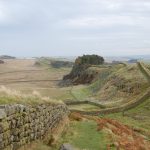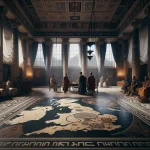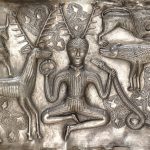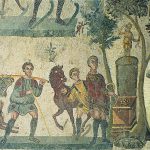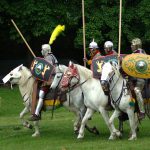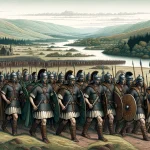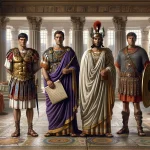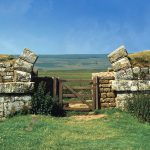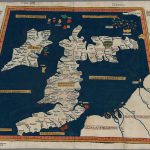Greta Bridge Roman Fort
Trajanic Auxiliary Fort (A.D. 98–117)
The site of the Roman fort at Greta Bridge stands upon a river terrace overlooking the River Greta. The long axis of the fort is aligned upon this terrace enhancing the defensive qualities of the east rampart. This rampart still survives to a maximum height of 3 metres, with some mutilation, and because of its location immediately adjacent to the river terrace, it has no ditch. The south defences of the fort are the best preserved and comprise the remains of a double ditch system, an earthen rampart, and a central causeway and gateway. The outer ditch, which is the most prominent, is up to 3 metres deep with a low counterscarp bank no more than 0.6 metres high. A medial ditch survives in the east up to 1.8 metres deep, with further traces of the ditch on the west side of the causeway. The causeway is 6 metres wide, and the corresponding gateway 6.5 metres wide. The south rampart stands to a height of 2.4 metres. The west defences are mostly disturbed by an adjacent track which follows a parallel course to the rampart, only the much abraded remains of the outer scarp of the rampart survives standing no more than 1.8 metres high. The north defences are now lost beneath the Morritt Arms Hotel. The interior of the fort exhibits faint traces of ridge-and-furrow which has subsequently been levelled. Two prominent rectangular platforms have been constructed overlying the abraded ridge-and-furrow, one in the north-east corner of the fort, the other in the south-east corner, which appear to be the remains of tees from a disused golf course. No wall faces are visible among the defences of the fort. To the immediate south of the fort, and also on the river terrace, lies a field of ridge-and-furrow cultivation. Find evidence suggests it was occupied from the early 2nd to the late 4th century AD.
There are ten Latin inscriptions recorded on stone in the R.I.B. for the Greta Bridge fort and settlement; four altarstones, two building-stones and four tombstones. In addition, a Roman milestone or honorific pillar has been recovered from the roadside near the settlement. The texts of all these stones are shown and translated below.
The Religion of Roman Greta Bridge
RIB 744 - Altar dedicated to a Nymph
To the goddess Nymph NEINE Brica and Januaria, her daughter, willingly fulfilled this in accordance with their vow.
NEINE BRICA ET
IANVARIA FIL
LIBENTES EX VO
TO SOLVERVNT
l. 2. The first five letters, as recorded, conceal the local name of the Nymph.
RIB 745 - Fragmentary dedication
… beneficiarius of the governor of the upper province, gladly, willingly, and deservedly fulfilled his vow.
RS
SEI
[.]ELLINVS
BF COS PRO
VINCIE
SVPERIOR
V S L L M
As Huebner (CIL) and Birley (Arch. Ael. 4th Ser. xi (1934) 133) suggest, the citation of Britannia Superior should indicate that this fort belonged to a different province, in this case Britannia Inferior (see Miller CAH¹ xii 36). A beneficiarius was a soldier, usually a legionary, seconded for special duties by favour (beneficium) of a specific senior officer; in particular the beneficiarius consularis, an officer on the governor’s staff, who might be out-posted.
RIB 743 - Altar dedicated to Mars
To the god Mars.
MARTI
No commentary.
RIB 746 - Dedication to Septimius Severus, Caracalla, and Geta
For the Emperor-Caesars Lucius Septimius Severus Pius Pertinax and Marcus Aurelius Antoninus Pius, both Augusti, and for Publius Septimius Geta, most noble Caesar, under the charge of Lucius Alfenus Senecio, their propraetorian legate.
PIO PERT ET M AVR ANTONI
NO PIO AVG ET ⟦P SEP GETAE⟧
NOB CAES SVB CVRA L
ALFENI SENECIONIS
LEG EORVM PR PR
L. Alfenus Senecio: governor of Britain a.d. 205-about 208 (see RIB 722).
Two building inscriptions have been recovered from Greta Bridge, both discovered in 1792 near the north gateway of the fort; an ansate slab dated to the beginning of the 3rd century, now in the Bowes Museum (RIB 746); also part of an inscribed slab, now lost (RIB 747).
RIB 747 - Inscription
… fallen down through age, under the charge of … centurion of the Sixth Legion Victrix … Postumius Urbanus … of Upper Britain ..
[...]HOÍ¡EVÍ¡MOLLINI
[... ]ILABS SVB CVRA
[...] 𐆛 LEG VI VIC
[... ]OST VRBANVS
[...]PERIORIS
[...] CITRA
[..] EM
[...]
No commentary.
RIB 751 - Funerary inscription for Maternus
Sacred to the spirits of the departed: Maternus lived ..
[..] MATERṆVS
VIXIT [...]
No commentary.
RIB 750 - Funerary inscription for Salvia Donata
To the spirits of the departed: Salvia Donata lived 8 years, 1 month.
SALVIA DONA
TA VIXSIT AN VIII M I
No commentary.
RIB 2279 - Milestone of Gallus and Volusian
For the Emperors, our Lords, Gallus and Volusianus, Augusti.
N GALLO
ET VOLV
SIANO
AVG
Gallus and Volusian, A.D. 251-3.
References for Greta Bridge
- The Roman Inscriptions of Britain by R.G. Collingwood and R.P. Wright (Oxford 1965).
Roman Roads near Greta Bridge
SE (8) to Carkin Moor SE (13) to Cataractonivm Itinera II et V: W (5.5) to Lavatris
Sites near Greta Bridge Roman Fort
- Greta Bridge Vicus (0 km)
Vicus - Bowes Temporary Camp (9 km)
Marching or Temporary Camp - Scargill Moor Temples (9 km)
Temple Or Shrine - Carkin Moor Roman Fort (9 km)
Auxiliary Fort - Bowes (Lavatris) Roman Fort (9 km)
Flavian Auxiliary Fort (AD 69–96) and Temple Or Shrine - Stanwick Camp (10 km)
Iron Age Hillfort - Piercebridge (Morbium) Roman Fort (13 km)
Auxiliary Fort - Piercebridge (Moribum) Vicus (13 km)
Vicus - Piercebridge (Morbium) Roman Bridge (13 km)
Roman Bridges - Holmes House Roman Fort (14 km)
Trajanic Auxiliary Fort (A.D. 98–117)
